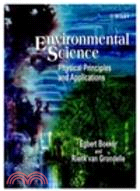| FindBook |
|
有 1 項符合
Rienk Van的圖書 |
 |
$ 2613 | Environmental Science - Physical Principles & Applications
作者:Boeker,Egbert/Grondelle,Rienk Van 出版社:John Wiley & Sons Inc 出版日期:2001-12-05 語言:英文 規格:平裝 / 362頁 / 2.5*18.4*23.5 cm / 普級 / 單色印刷  看圖書介紹 看圖書介紹
|
|
|
- 圖書簡介
Aimed at a first course in environmental physics, environmental science, environmental analysis, or environmental monitoring. This text can be used by first year students and above, and takes a scientific approach as opposed to a social or political one. Mathematics is kept to a minimum, although some background (school) knowledge of science is assumed. Courses would be taught in physics, environmental science and physical science departments.
Comprehensively covering the field, this book brings together the latest developments, theories, research and concerns, from both the scientific and social sides. Placing the environment firmly at the centre of the scientific agenda, it provides all the background needed by readers to fully understand this important and often 'hype-driven' subject. Whilst mathematics is introduced where necessary, it is carefully explained and kept simple, with derivations generally being avoided. Wherever possible, topics of current concern and relevance are included, and many examples, features and appetisers or mini-case studies are included, frequently drawn from publications such as New Scientist, Nature, Science, Physics Today and Scientific American. The book starts with a general overview of the subject, and then moves on to cover climate, energy, pollutants, noise, measurements and social aspects. - 名人/編輯推薦
"...I would regards this as one of the more accessible and useful introductory texts in environmental physics..." (Chemistry & Industry, 19 August 2002)
"...This book should be a good choice for environmental science teachers..." (Jnl of Environmental Quality (September/October 2002)
"...very valuable to all students taking a course in environmental sicence..." (The Int Jnl of Environmental Studies, Vol.59, 2002)
"...well adapted to the needs of an environmental science course..." (Int Jnl of Environement & Pollution, Vol.18, No.1, 2002)
"...valuable to all students taking courses on environmental sciences…" (Int Jnl of Environmental Analytical Chemistry, Vol.82, No.10, 2002)
"...the material is fresh and to the point ...It is a highly recommended introductory text..." (Environmental Geology, January 2003)
"...an excellent overview...very well written...material is fresh and to the point...highly recommendable..." (Environmental Geology, Vol 43(3), Jan 2003) - 目次
Preface
Acknowledgements
1. Introduction: A Physical Approach to Environmental Problems
What are Environmental Problems -
Pollution
The Economic and Social Context
Sunlight and the Solar Spectrum
The Greenhouse Effect
Transport of Pollutants
The Carbon Cycle
2. Weather and Climate
Energy Transport
The Atmsophere, Vertical Structure and Motion
Horizontal Motion of Air
The Oceans
3. Climate Change
Natural Changes of Climate
Human induced changes
Consequences of Climate Change
Reactions to Climate Change
4. Conventional Energy
Physics of Heat
Heat and Power: Thermodynamics
Converting Heat into Power: Problems and 'Solutions'
5. Carbonfree Energies
Renewable energies
Nuclear Power
6. Making up the Balance
Greenhouse Gases, Pollution and Resources
Defining the task
7. Transport of Pollutants
Basic Concepts
Dispersion in the Air
Dispersion in Surface Waters
Dispersion by Groundwater
8. Noise
Physics of Sound
Human hearing
Reducing Sound Levels
9. Environmental Spectroscopy
Basic Spectrospcopy
The Solar Spectrum at Ground Level
Experimental Techniques in Environmental Spectroscopy
Solar UV, Ozone and Life
10. Geophysical Methods
Radioactive Clocks
Isotope Ratios as Environmental Sensors
Magnetic Surveys
Seismic Probing
11. Science and Society
Finite Resources of Energy
Pollution and Health Effects
Environmental Policy
Thinijhng about the Environment and Human Life
The Responsibility of the Scientist
Appendices
References
Index
|










